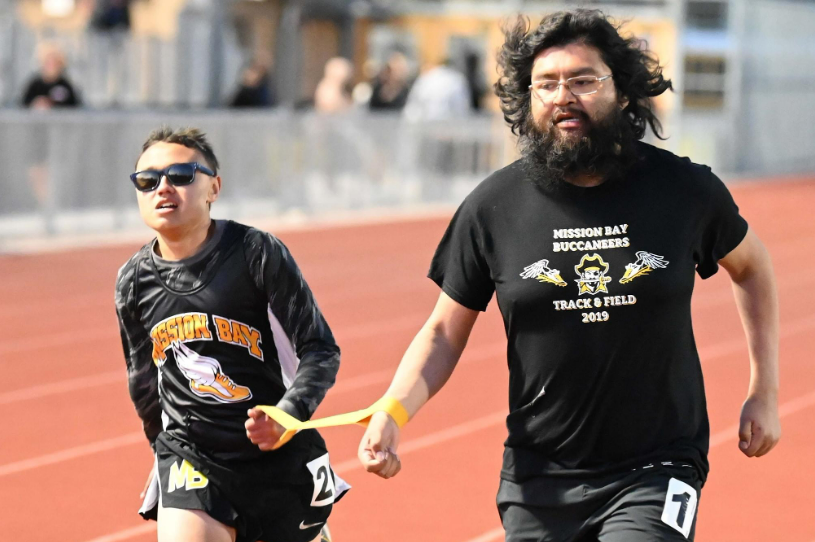
Meet Chris Adamson. A freshman member of the Mission Bay High School track team. His main events are the 100m and 200m distances. His personal best is 16.55 seconds for the 100m and 35.6 seconds for the 200m races. Adamson is blind and uses a guide runner every day at track practice and at his track meets. His guide runner, David Cervantes, is also his one-on-one classroom aide.
“I was born with impaired vision and then while I was in third grade at Sessions Elementary went totally blind,” Adamson said. “I have Alström Syndrome.”

With special education support, involved parents, and incredible personal determination, Adamson set about learning to read and write Braille. There are many styles or types of Braille. The first style él learned is known as UEB, Unified English Braille. UEB is based on the style of Braille first invented by Louise Braille in 1824. The Braille characters are formed using a combination of six raised dots in a 3 por 2 matrix, called a Braille cell. Adamson learned Unified English Braille over one summer when he was 9 years old.
Understanding that middle school and later high school would require learning and communicating in ever increasingly complex subject matter, Adamson set out to learn Nemeth Braille in sixth grade at Pacific Beach Middle School. Nemeth Braille, invented by Abraham Nemeth in 1952, is a more complex and specialized style of Braille used for science and mathematics instruction. In sixth grade, Adamson also started learning computer Braille.
Adamson met Cervantes at the beginning of sixth grade at Pacific Beach Middle. The two have been a tight team ever since. “It took a while to develop trust and work out the communication between us,” Adamson said. “Now it’s all good.”
What are some of the biggest challenges for Adamson in high school? Surprisingly, it’s not the track part. Adamson said his two greatest challenges are making sure that text material needed for class is ordered early and the description of on-screen visual imagery.
“For example, if I am assigned a novel like ‘Great Expectations’ it needs to be sent to the VI (Visually Impaired) department to be put in Braille for me prior to classroom use. I always need the Braille material as early as possible so I don’t fall behind,” Adamson said.
Regarding the challenge of descriptive imagery, Cervantes explains: “So much of instruction comes through a screen. If a film or video segment is not available with ‘audio assist,’ I am constantly trying to describe the on-screen images as precisely as I can, with as much detail as possible. It is a real challenge. I need to be accurate as well as concise.”
In addition to assisting Adamson five days a week at school, and at Saturday track meets, Cervantes is pursuing a physics major and child development minor at San Diego State University. Cervantes is pleased that his assignment with Adamson is now in its fourth year.
“Continuity with the student/aide match has benefits for both parties. It allows them to build stronger support and to better understand each other’s needs and preferences,” Cervantes dicho. “This will lead to improved academic and personal outcomes for the student, as well as greater job satisfaction for the aide. And, I have developed a strong connection to Adamson’s family.”
Track practice is every day after school. Mission Bay track coach Danny Perez is excited to have Adamson out for track.

“I have worked with a number of para-athletes in my career,” said Perez. “From the research I have done, Adamson is the only blind runner competing on a California high school track team this year. He is setting records and has qualified for the state meet in Fresno at the end of May.”
Cervantes is Adamson’s guide runner. At track meets, Cervantes has the outside lane, usually No. 9. Adamson has lane 8. They are tethered with a short strap.
“Running tethered to another person involves a great deal of trust,” Adamson said. “We are in constant communication so that I stay in my lane, that I cross the finish line ahead of Cervantes, and that I am relaxed enough to run at my top pace.
“The 200m distance is more difficult for me. Not only is it longer, but also the track curves. Cervantes needs to communicate the curves to me to keep me in my lane,” Adamson said.
Facts about Chris Adamson:
1.) His older brother, David, attends Mission Bay and plays tennis.
2.) His favorite food is sushi.
3.) He plays chess both online and with a Braille board and chess pieces.








